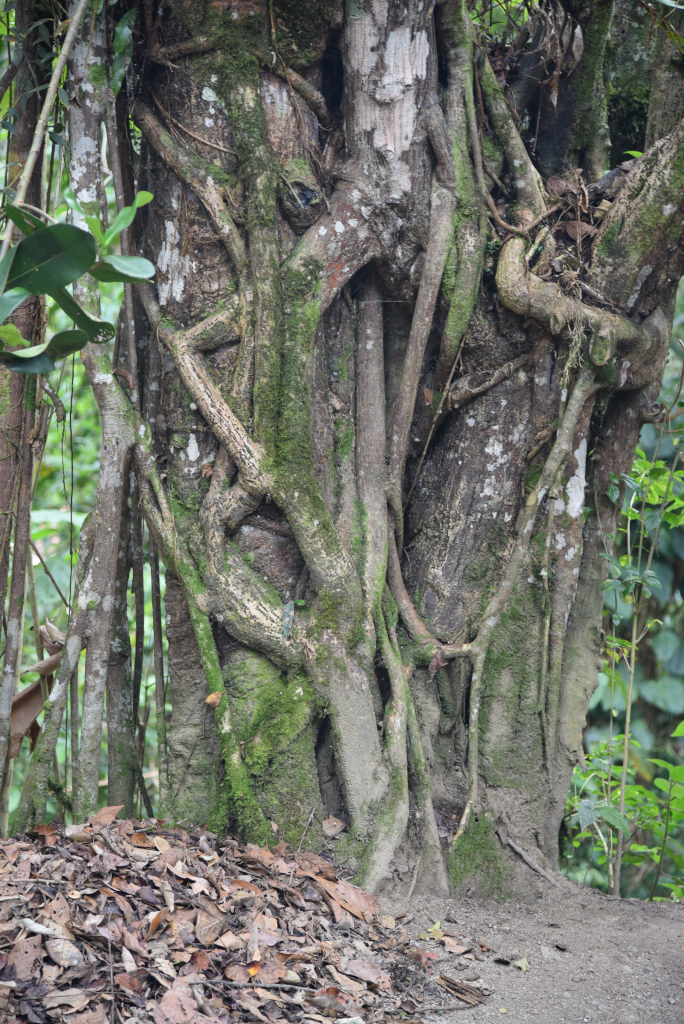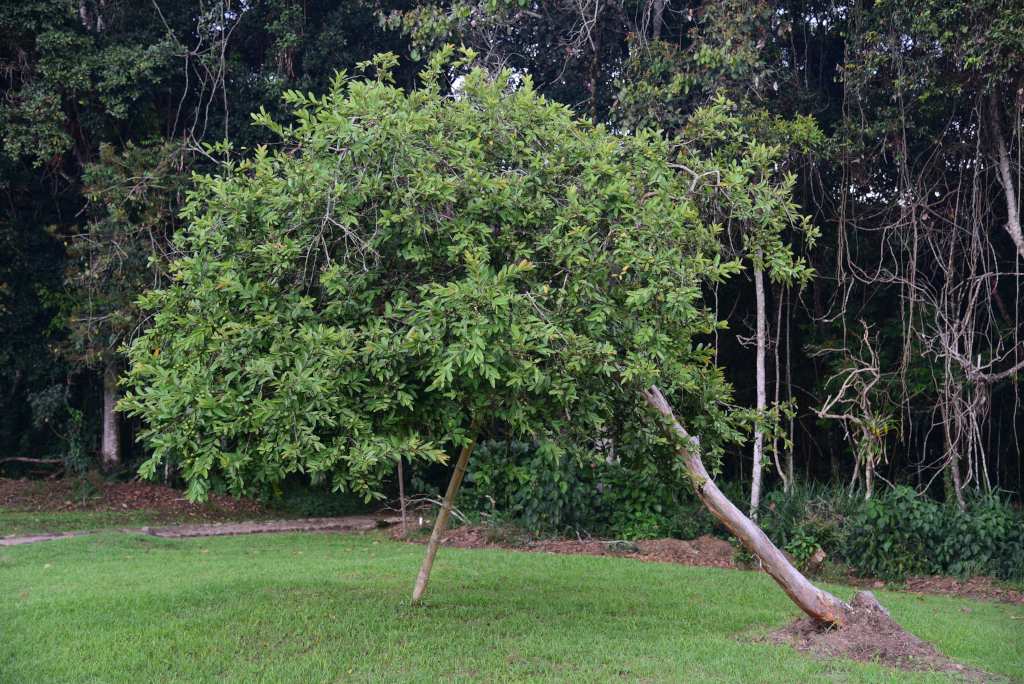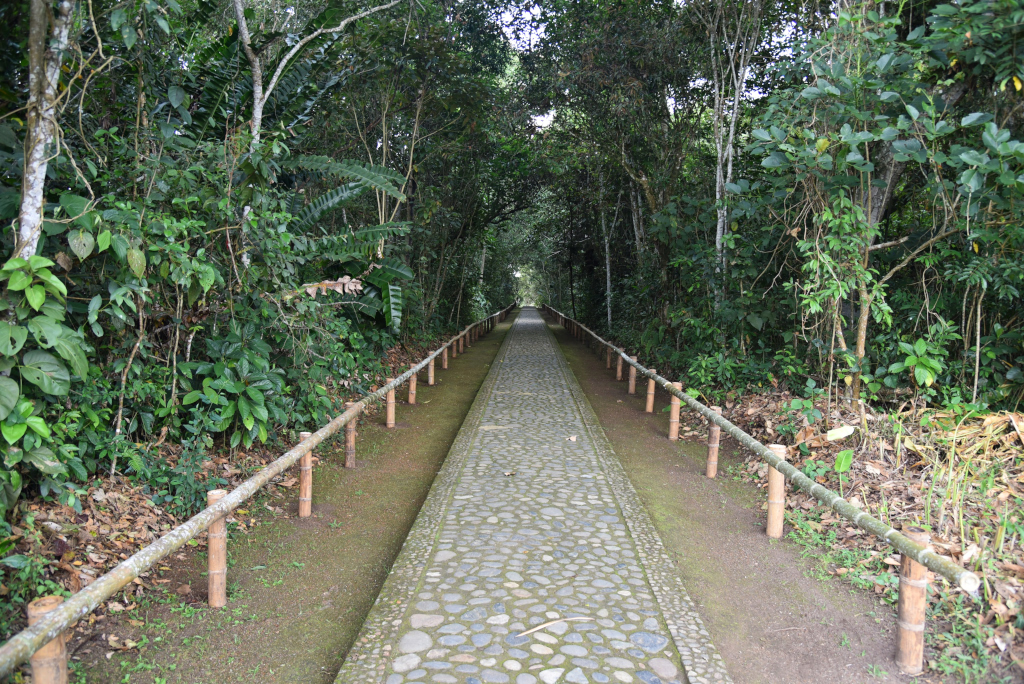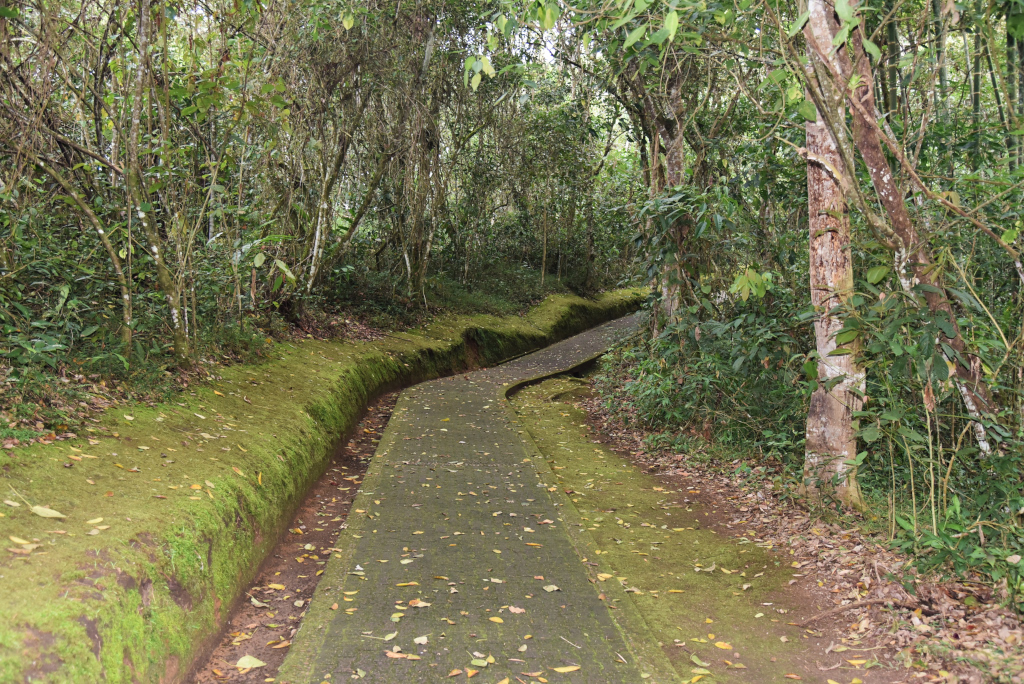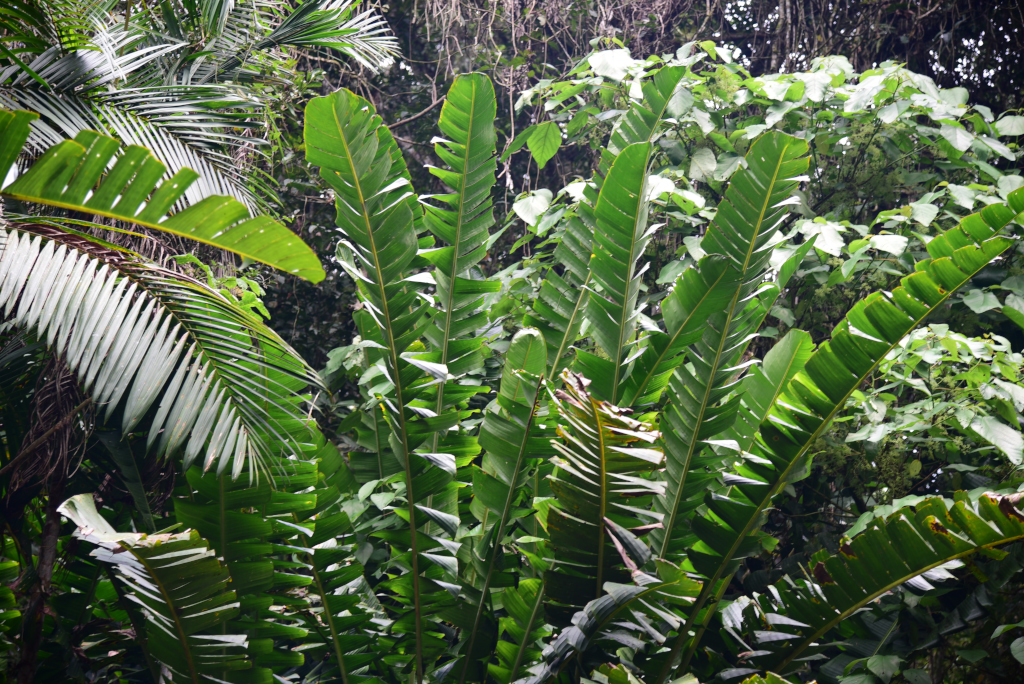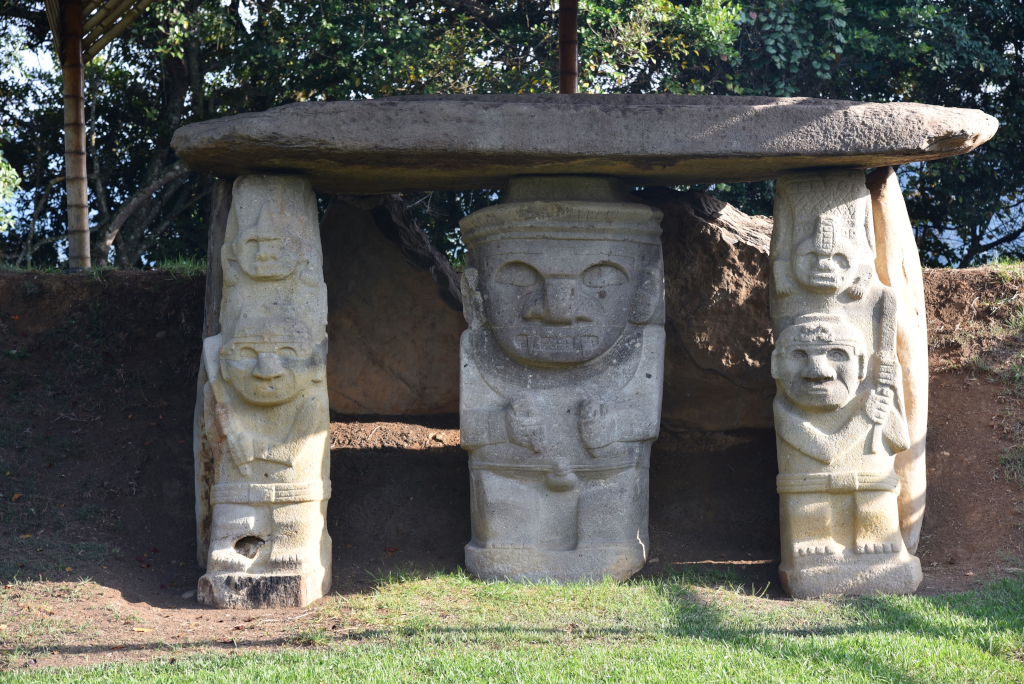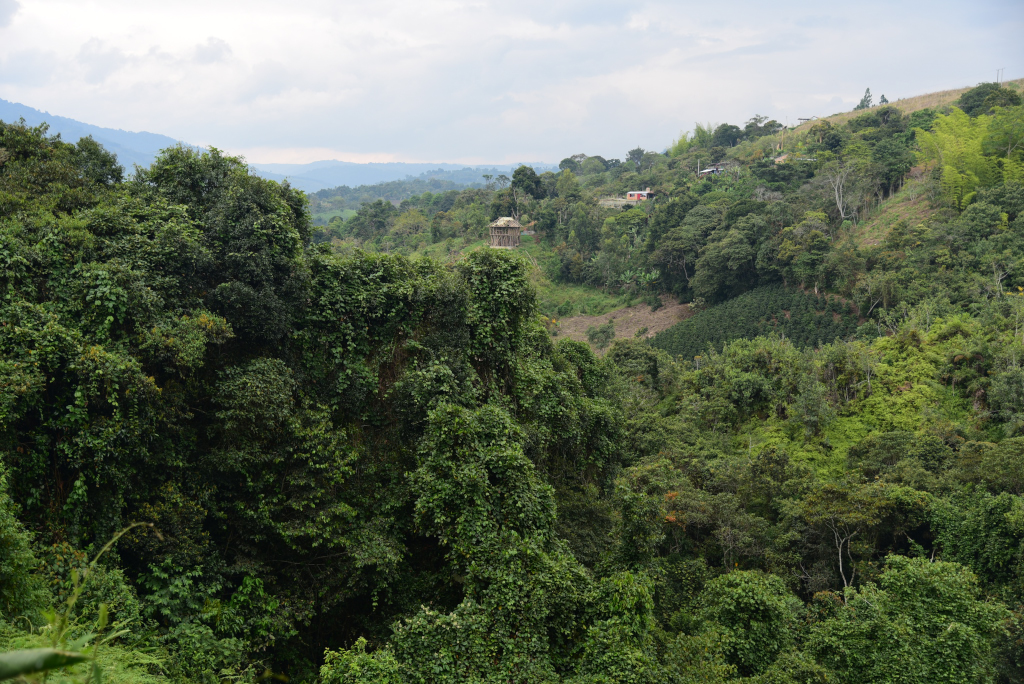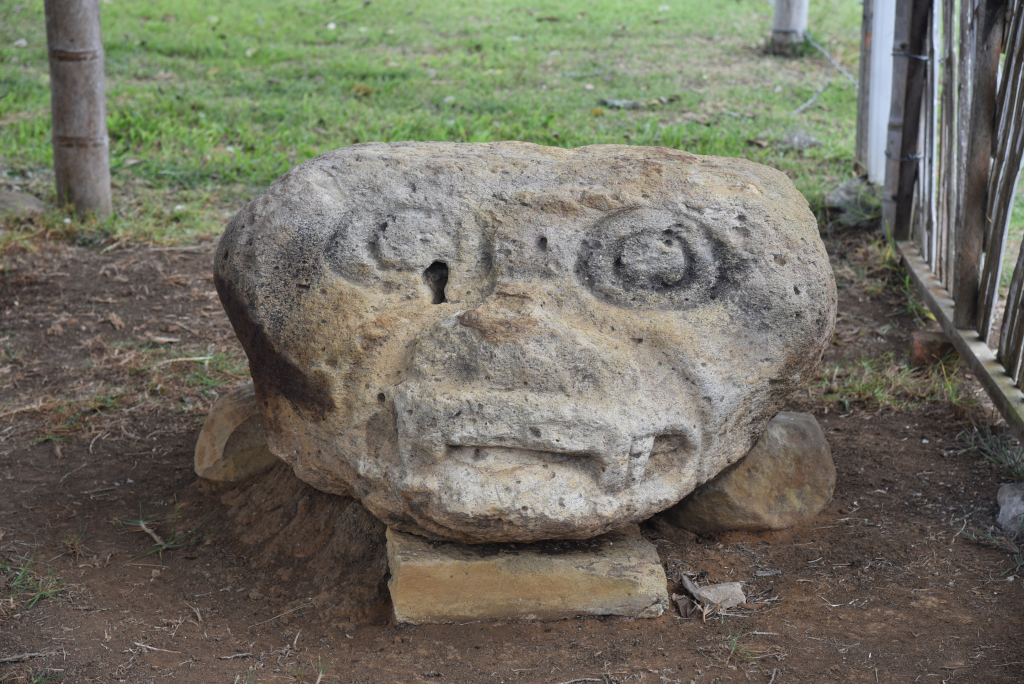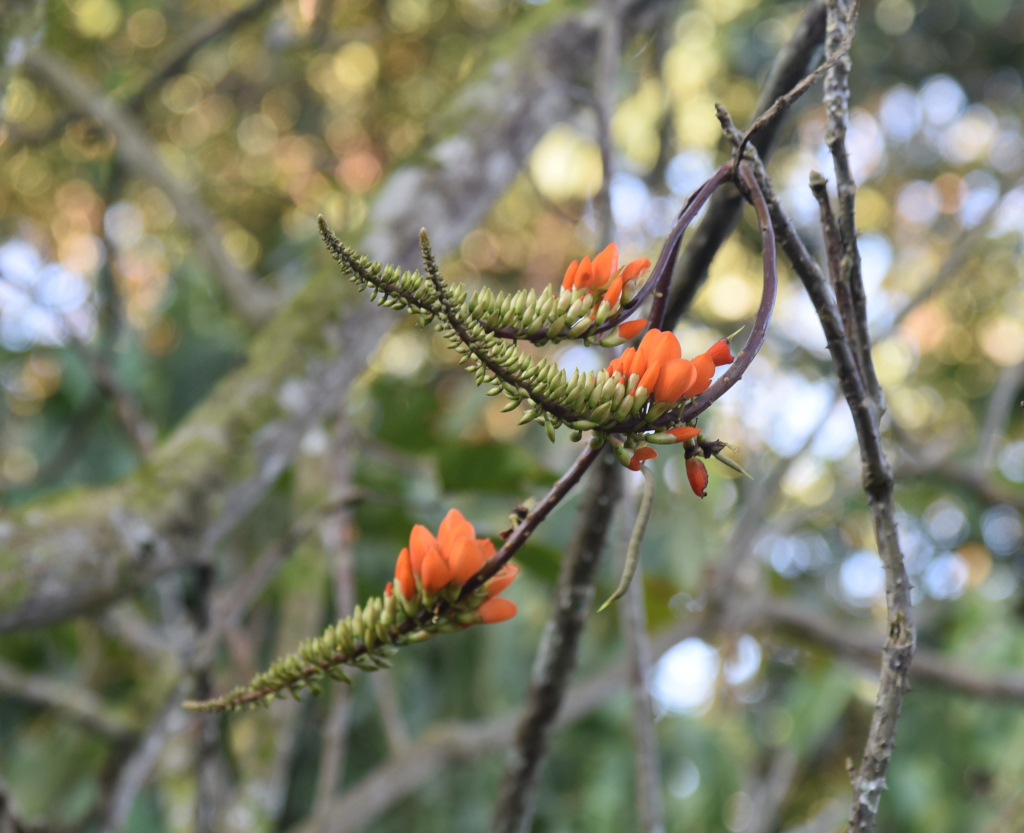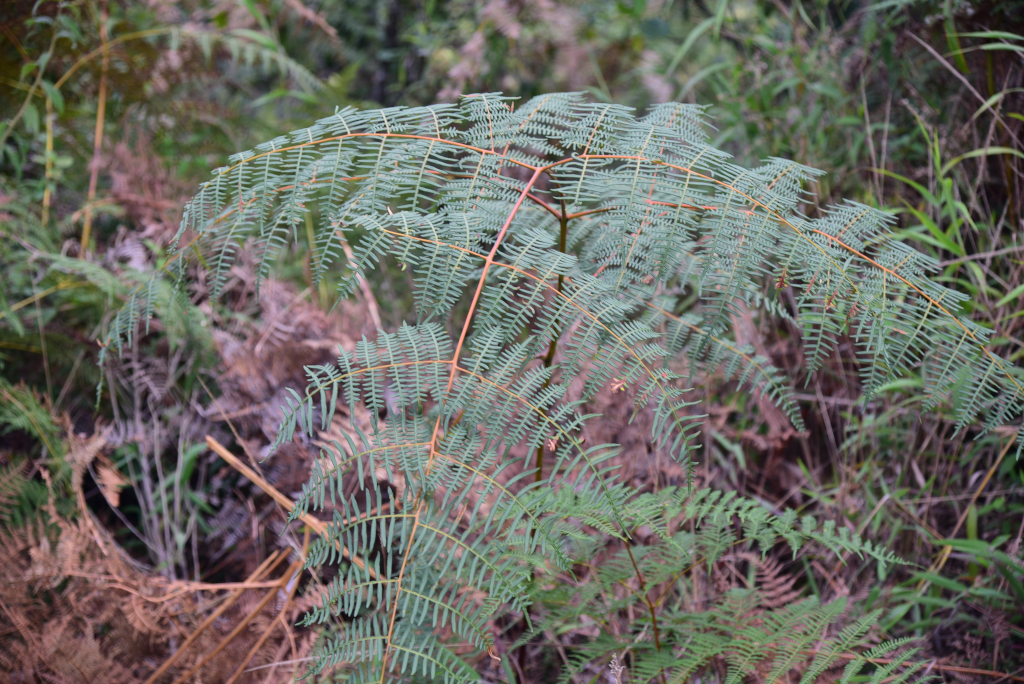March 21, 2018
The Bosque de las Estatuas provides a stunning introduction to the Parque Arqueológico De San Agustín, the wide trail weaving up and down among the stone sentinels hearkening from a different era, erected on plinths of differing shapes and sizes. The statuary follows a common expression, stylized squat figures, either including heads only, or entire bodies. Some figures have been too heavily eroded for much to be discernable. The head could be covered or unadorned, while the bodies appear to be crouching, with hands wrapped around legs or some other object, staring with bug eyes blankly into the distance.
What the objects the figures are clasping seems obscure, although a sceptre or some other object bearing special powers or importance comes to mind. Some figures are reasonably anthropomorphic, while others seem garish, almost freakish, possibly representing evil spirits, intended to ward threatening parties away.
A powerful component of the presentation of the statues is the thick forest around us, virile vines hanging off of mature trees, aerial roots of trees seeking sustenance in the thin tropical soil, a wild array of flowers, including orchids, hibiscus, philodendrons, ferns, heliconias, epiphytes, palms, mature hardwoods, and so on. I am relentlessly fascinated and drawn in by the beauty of the natural surroundings, although it also has to be said that at this elevation, the heat and humidity are not punishing, and the paths are wide enough to create sufficient air circulation.
A lengthy paved corridor out of the forest connects the Bosque de las Estatuas with Mesita B, one of a number of compounds the statuary is situated in. It is my understanding that some of the statues were found where they are being currently displayed, while others have been moved to their present location for effect. The undulating trail is shrouded on both sides by evocative local vegetation, including flowering bushes, ephiphytes, hanging vines, heliconia and orchids comprising the bulk of the exotic flora.
The formal excavation of Mesita B took place under the leadership of Konrad Theodor Preuss in the early 20th century, by which time much of the site had been plundered, and yet enough of the funerary sites remained to garner some understanding of the culture. The site of Mesita B was apparently a residential compound in the culture’s Formative period, ranging from 1,000 to 600 B.C., and became a funerary site by the Classical period (0 to 900 A.D.), including at least 63 statues.
The structure of the grave sites follow a similar pattern, the squat, stylized statues guarding tombs encased in dolmen-like slabs of rock. The grave sites located on the mesita are protected by shelters built of guadua bamboo and corrugated metal roofs, set on a closely cropped lawn, and surrounded by thick forest. Each of the mesitas features large, covered benches built of the local giant bamboo from which to enjoy the vista of the historic enclave.
One exceptional statue features a garishly grinning figure, unusually small, clasping a miniature version of the same figure that could be a child. Or how about a voodoo doll? Flanking the humanoid sculpture are two blocks of stone sculpted with leering faces, possibly spirits intended to guard the deceased. At another gravesite, a bulkier statue holds what looks like a shrunken head amulet, the face grinning fiendishly while the accompanying statuettes on either side bear somewhat plaintive expressions, with human-like figures appearing to carry another person on the back.
While most of the statues appear to be of humans or human-like figures, there are occasionally statues clearly intended to represent animals, such a huge bird with piercing eyes, or elsewhere, a reptile of some sort. And what the significance of the animals should be isn’t clear, either.
The graves themselves are built as passages to the physical burial area, constructed of large relatively and symmetrical slabs of stone.
Wandering around the mesita with my camera, transfixed by the display of gravesites and statues in the fecund setting, my eyes manage to lock onto a colourful, plumed bird that has swooped into one of the neighboring trees. Normally, this would not be an issue, but I am simply not a birder – I just don’t have it in my blood. But Colombia is famous for its variety of bird species, an exotic-looking creature has just landed in a neighboring tree, and I am intent on documenting the event! It later turns out to be a green jay, which is a fairly anti-climactic name, but the images of the bird speak for themselves.
Mesita C is located at the end of another long stone path, framed by the jungle. The grave sites here are also atmospherically situated on the sprawling lawn, surrounded by forest. This portion of the park corresponds to the classical period, between 1 and 900 A.D. Originally, the site contained a grave complex accompanied by 15 statues and surrounded by 49 simple graves. Only a subset of the sculptures originally found at the location are now on display.
The statues feature an array of garish expressions, although not much else is evident on the statues. Humorously, some of the squat figures feature fangs, which would suggest animals or menacing spirits. And for the most part, the hands hang limply in front, the size of the head typically far in excess of that of the arms and hands. Legs are almost never visible on these figures.
The Fuente de Lavapatas is one of the most exciting parts of the entire park, a broad rock face into which stylized carvings of animal figures are still visible, and over which a creek flushes its water. Much of the detailing has been lost over the centuries, but the effect is still dramatic, visible largely from the bamboo bridge was has been built over top. The figures of humans, reptiles and amphibians etched into the rock face were thought to serve ceremonial purposes. Originally, water was fed into the area by means of three entrances, and in feeding through the rivulets of the sculpted area, produced small waterfalls. The Fuente de Lavapatas is thought to originate in the Classical Period.
Now comes the hard part – climbing a long staircase past the vendors’ exhibits and employees shacks to a point where the forest carpeting the site around us is visible below. The heat and humidity hadn’t worried me previously – but reaching the top of the hill and the long passage running towards the top of the hill, I am completely drenched and exhausted. Relative to the rest of the park, the funerary remains are not that spectacular, consisting of a few covered tombs with a handful of garish and inscrutable states, although the setting is spectacular. Around us, the verdant hills of the region are visible, the rich patches of forest and flowering vegetation, and the beautiful sky, with its big white puffs of clouds.
I conclude my visit to the archeological park with Mesita A, which consists of more presumed graves of varying sizes spread out over the immaculate grass surface, each of the pits enclosed by low bamboo fencing. As with the rest of the park, the mesita is framed in a tapestry of green, the colours growing richer and darker with the progress of the afternoon. A few small groups of Germans trudge serenely through the area, as I rush back and forth to take just the right photos.
Mesita A was the first part of the park to be converted into tourist attraction at the beginning of the 20th century. Mesita A was a residential zone in the third Formative period (300 B.C. to 1 A.D.). It features two of the largest funerary mounds of the Classical period which rose to four metres in height and 30 metres in diameter.
The voice calling ‘Hola’ is not yelling into a cell phone but yelling at me. Why? The trail I thought leads to the entrance is in fact closed, and to return, I have to loop back via the trails I came to Mesita A with. Of course, I can’t resist getting into a long conversation with the warden regarding Colombian regional culture, the Semana Santa in Popayán, which is more remarkable than I can imagine (am trying not to get too excited, and just hoping the AirBnB experience doesn’t go sideways for some reason), and different types of Colombian music. But in the end effect I am killing time, as I should be rushing back to the entrance to see at least some of the museum.
There is nothing like having connections. At the entrance is the warden who I thought I had left behind in Mesita A. He jokes that he has his secret ways of leaving the parque, having trekked through the backwoods in the monte to get here. I have to assume the museum is closed, but he assures me I can still visit, calling emphatically to the guard I spoke to earlier on, standing on the terrace of an upper corridor of the museum.
The museum features more of the kinds of statues that are found throughout the park with supporting descriptions, although the first impression is that little is known of the civilization represented by the remains found in the San Agustín area. What did the statues represent? Funerary figures? Gods or spirits? Were they decorative? What was intended by the manner in which the humanoid figures were positioned?
What is known is that they were placed amongst others at larger grave sites with bigger figures and more articles, heralding deceased that were more powerful, influential, or wealthy. In the absence of concrete and plausible conclusions that can be drawn about the culture, a good starting point would be to extrapolate from today’s cultural norms.
The motive for visiting the museum, at least some of the museum, is that the entrance fee allows the main archaeological site as well as two additional smaller sites to be visited over a consecutive, two-day period. I had tentatively planned on taking a tour tomorrow, but given that the tour would begin early, I won’t be able to really fit in a museum visit prior to going on the tour, assuming that it would take all day.
The jaunt back to the gates of the resort: nothing like being in the country, the quiet, the lush green setting, the fragrance of the vegetation and the ubiquitous flowering plants, and best of all, remaining far away from the town of San Agustín.
A different staff member greets me at the gate and leads me back to the main building. I am then told that there is a problem with my room reservation, as the rate I was offered was for the inferior rooms, not the superior rooms. I go momentarily on the offensive, but in reality don’t really care, since I reap no benefit from the two-story rooms on the upper floor – I could just as well stay in one of the smaller rooms on the lower floor, which are already sufficiently large for me. But he relents: I can stay in the room for now … or until I leave …
The menu at the Hotel Huaka-Yo restaurant is very simple, and wouldn’t necessarily be that promising, if it weren’t simply more of a matter of enjoying the serenity of the place. One of the two tables that are occupied vacates soon after I arrive, the only other occupied table the older manager with two very young English-speaking women. So what exactly is he up to? The young waiter continues his polite banter, but can’t be reeled into a conversation. Good for him!
Unfortunately, the much publicized pizza is mediocre at best, but again, that’s OK, considering the overall experience. At least the manager had the honesty to warn me that the wine on stock is unequivocally mediocre. The saving grace is the fresh fruit juice, sour sop and mango, and then a soursop and lulo to take back to my room, for the purpose of mixing with better things.
I can’t seem to understand why my back is killing me. I haven’t done anything out of the ordinary to provoke my back, have I? Well, yes I have: spending hours sitting on a collapsing mattress, hunched over my laptop set up at the wrong height on the dresser at the Hotel Hipona Plaza in town. It would also help that I went to bed earlier, given how early I typically wake up. But the writing and photo editing commitments in addition to researching further travel is simply too time-consuming – I really would love to stop for a week and catch up on everything, but then I am down to the wire with my Colombia trip, and every day prior to departure in mid-April has been mapped out already. When it comes to making a choice between traveling and writing …



